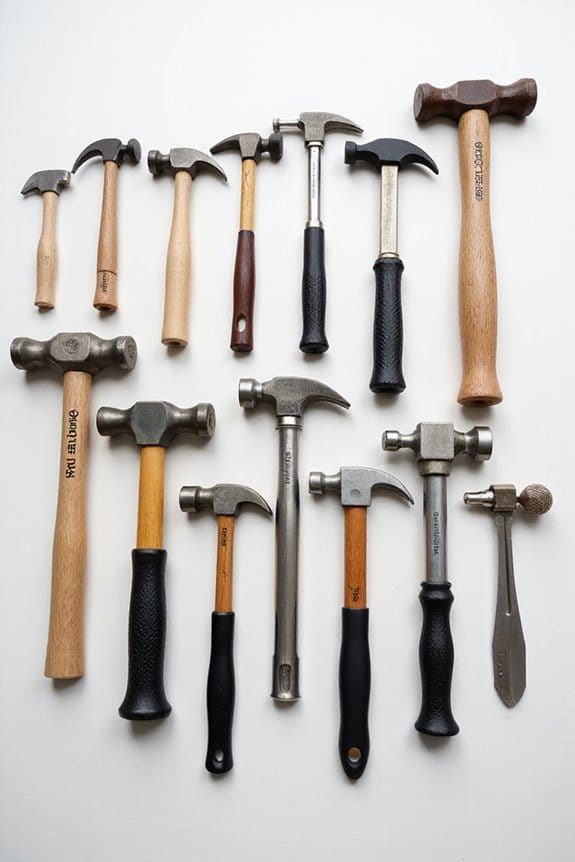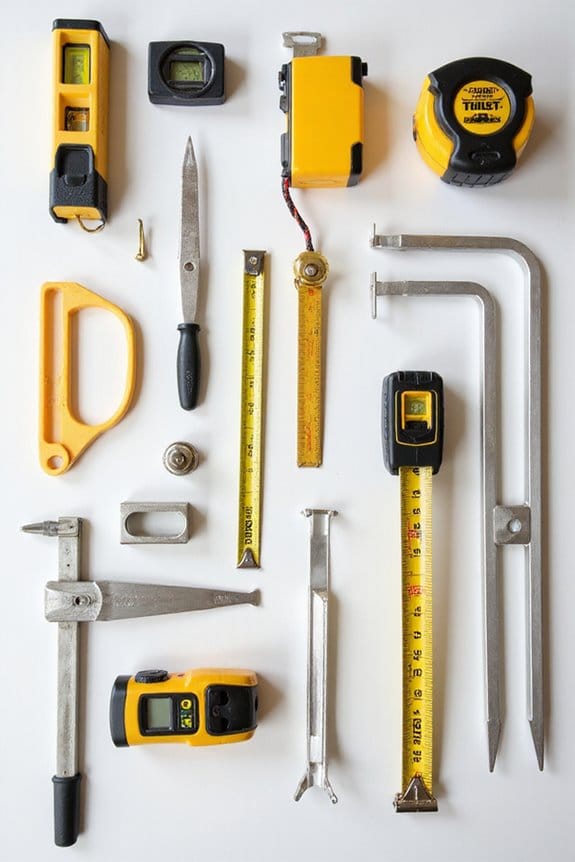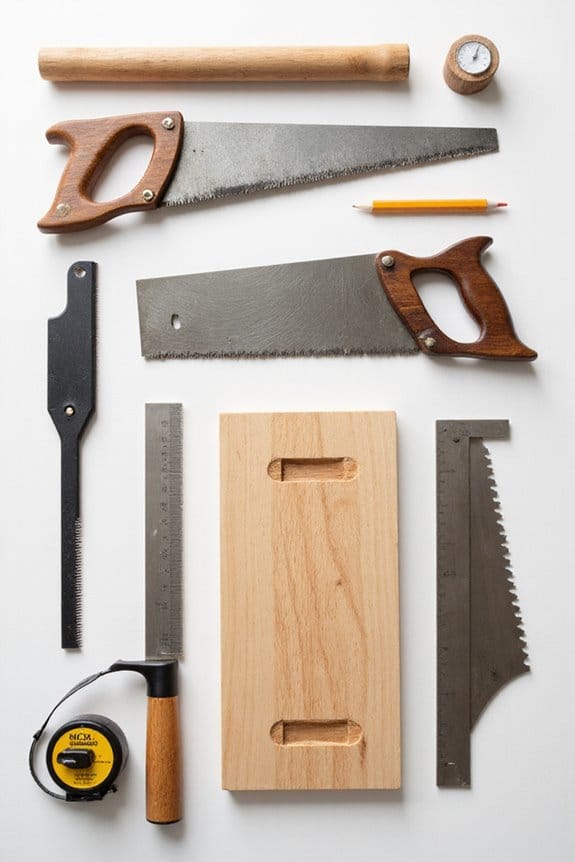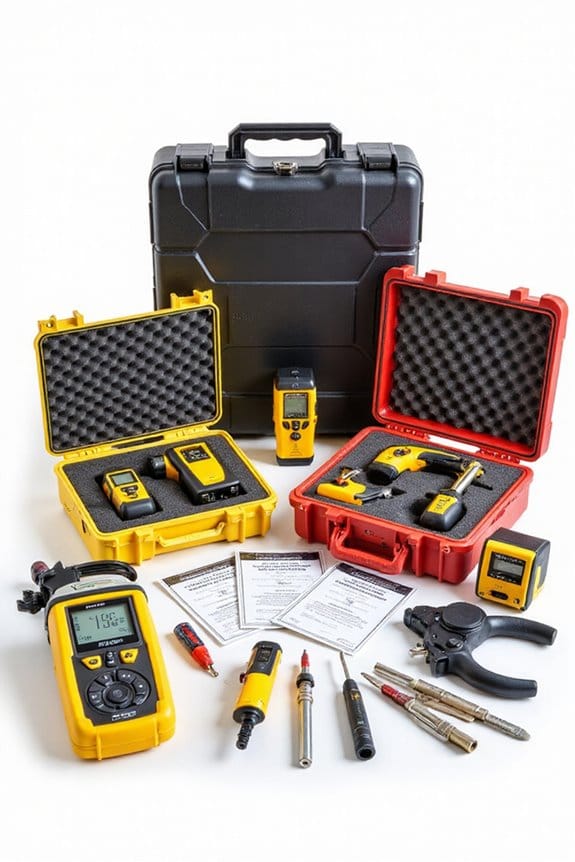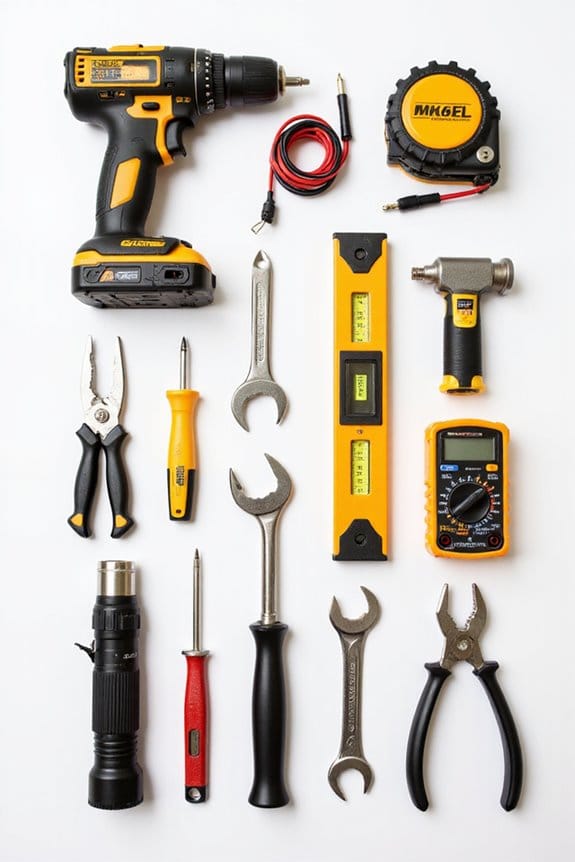Choosing the right hammer weight is key, and here’s how I do it. First, consider the task: lightweight hammers (under 1.5 lbs) are perfect for delicate jobs, while heavier ones (2.5-4.8 lbs) handle demolition. Next, think about balance—too heavy and you risk fatigue; too light and you lose power. Finally, make sure it fits your hand; a comfortable grip is essential. Keep these in mind, and you’ll pick the perfect hammer weight in no time! Want more tips?
Key Takeaways
- Assess the task: Choose lighter hammers for delicate tasks and heavier ones for demolition or heavy-duty work.
- Consider user characteristics: Select a hammer that matches your height, strength, and hand size for optimal control.
- Evaluate frequency of use: Lighter hammers reduce fatigue during prolonged use, enhancing comfort for extended projects.
- Focus on balance: A well-balanced hammer feels lighter and improves control, reducing the risk of damaging surrounding materials.
- Match hammer weight to nail size: Use medium-weight hammers (16-20 ounces) for general carpentry, balancing power and control effectively.
Understanding Hammer Weight Categories

When you’re choosing a hammer, it might seem like just picking a heavy chunk of metal, but understanding hammer weight categories can really enhance your efficiency and safety. Here’s a quick breakdown of hammer types and their weight variations:
- Framing Hammers: Weigh between 550 to 900 grams, perfect for heavy-duty construction.
- Club Hammers: These weigh around 0.5 to 2 kilograms, great for precision tasks.
- Medium-Class Hammers: Ranging from 1900 to 3700 pounds, ideal for versatile jobs.
- Large-Class Hammers: Heavier than 5000 pounds, designed for high-power demolition.
Choosing the right weight isn’t just about power; it’s about balance. A lighter hammer might be easier to swing, while a heavier one delivers more force. It’s all about finding what suits your needs!
Lightweight Hammers for Delicate Tasks
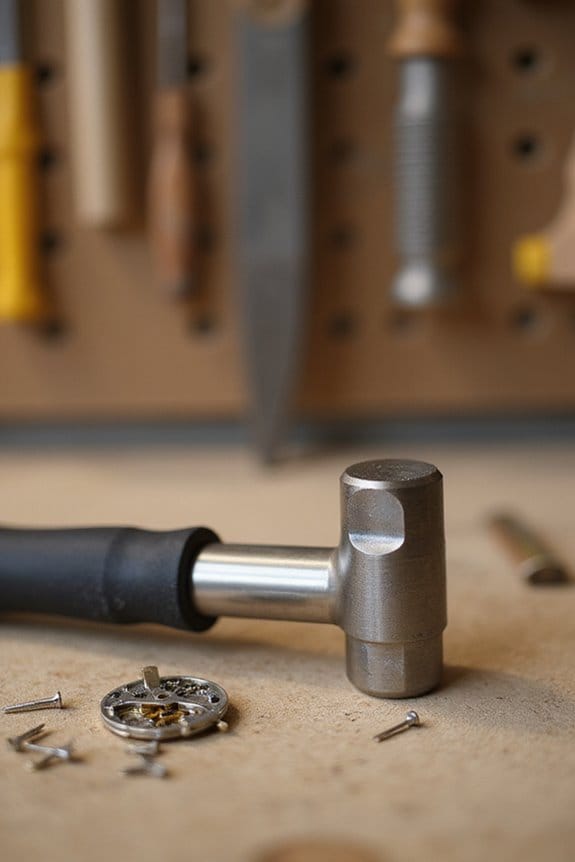
While it might seem counterintuitive to use a lightweight hammer for delicate tasks, I assure you it’s all about finesse and control. Here’s why you should consider them:
- Tack Hammer: Perfect for driving small tacks into upholstery without damaging the fabric. Its magnetized face holds tacks steady, making your job easier.
- Soft-Faced Hammer: With replaceable faces made of rubber or plastic, it’s gentle on surfaces. You can tap away without fear of marring your material.
- Precision: Their small heads allow for accurate strikes, which is essential for tasks like fine carpentry or light metalworking.
- Comfort: Lightweight design means you can work longer without tiring. Trust me, your hands will thank you!
Medium Weight Hammers for General Carpentry
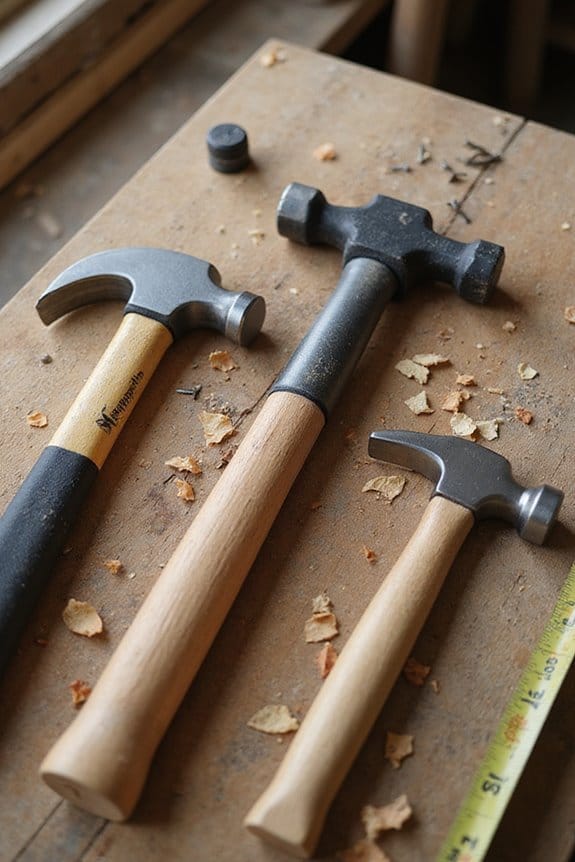
Medium weight hammers, typically weighing between 16 to 20 ounces, are your go-to tools for general carpentry tasks. They strike a perfect balance between power and control, making them ideal for everything from framing to cabinetry. Here are some key hammer features to take into account:
- Versatility: They handle medium nails and fasteners well, so you won’t need multiple tools.
- Comfort: Their weight reduces user fatigue during long projects, which is a game-changer.
- Control: A well-balanced medium weight hammer minimizes the risk of damaging surrounding materials.
Whether you’re a pro or a DIY enthusiast, these hammers offer excellent performance without feeling like you’re swinging a sledgehammer. Trust me, your wrists will thank you!
Heavyweight Hammers for Heavy-Duty Work
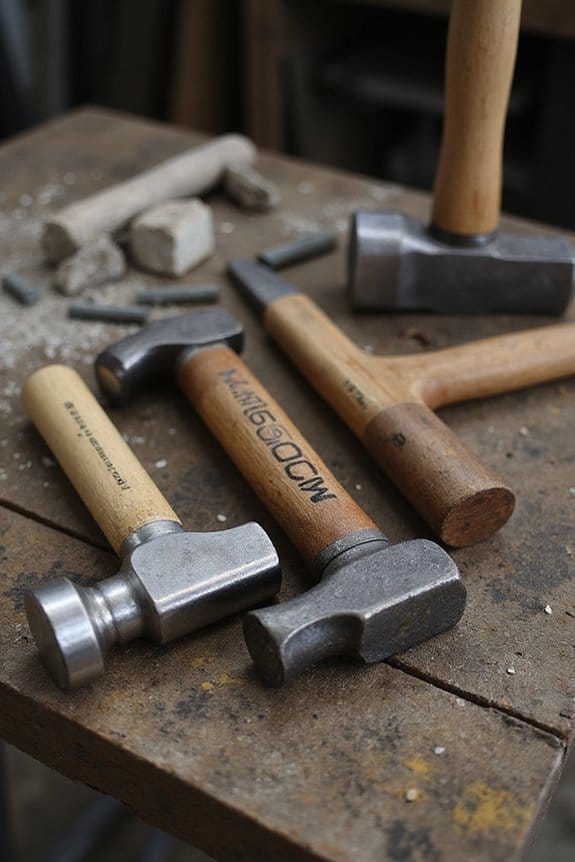
Heavyweight hammers are essential tools for anyone tackling heavy-duty work, especially if you’re looking for that extra oomph in your strikes. These tools, typically weighing between 2.5 and 4.8 lbs, shine in heavy hammer applications like demolition and chipping. Here are some key points to evaluate:
- Material Matters: Look for forged or cast steel heads for durability and impact resistance.
- Handle Comfort: Opt for fiberglass handles with ergonomic grips to reduce fatigue.
- Safety First: Always maintain a proper grip and think about using a safety tether, especially when working at heights.
Factors Influencing Hammer Weight Choice
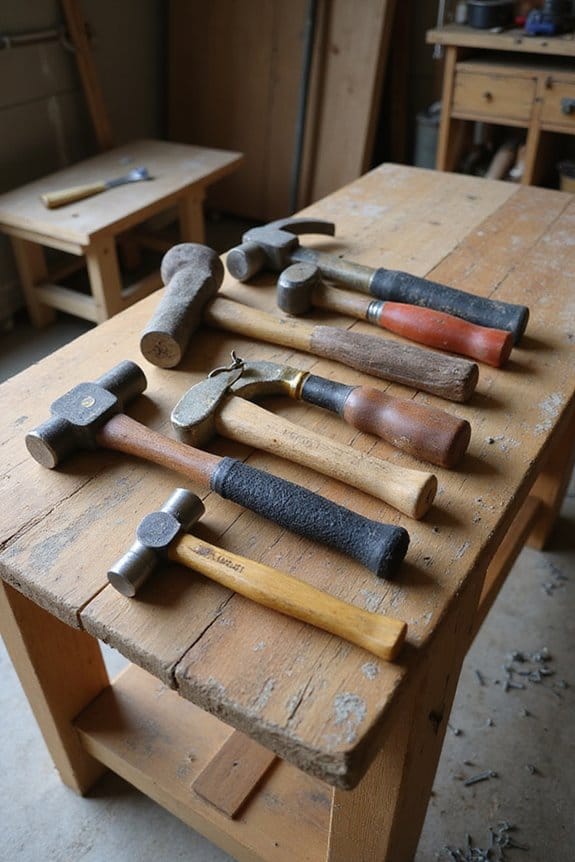
When it comes to choosing the right hammer weight, several factors come into play that can really make or break your project. Here are some key considerations:
- User Characteristics: Your height, strength, and hand size matter. Taller folks might manage heavier hammers better, while smaller hands need a comfortable grip.
- Task Requirements: Is it delicate work or heavy-duty? Lighter hammers are great for finesse, while medium weights balance control and power.
- Frequency of Use: If you’re hammering away all day, go lighter to avoid fatigue.
- Balance and Design: A well-balanced hammer feels lighter and gives you better control.
Specialized Hammer Weights for Specific Tools
Choosing the right hammer often feels like an art, especially since different tools have specialized weights tailored for specific tasks. Here’s a quick look at some common hammer types and their tool applications:
- Brick Hammers: Weighing 450 to 680 grams, they’re perfect for masonry work, with a chisel and flat face for cutting and shaping bricks.
- Rock Hammers: Designed for geology, they feature a pointed pick and flat face, balancing precision for outdoor tasks.
- Ball Peen Hammers: Essential in metalworking, their varied weight helps with shaping metal without excessive force.
- Rubber Mallets: Lighter and softer, they’re great for assembling furniture without damaging surfaces.
- Sledgehammers: Heavy hitters for demolition, these require strength and control for effective use.
Choosing wisely keeps your projects on track—and your hands happy!
Industry Standards and Variability in Hammer Weight
It’s fascinating how specialized hammer weights can cater to various tasks, but there’s more to the story. Understanding hammer weight standards and tolerances is essential for effective tool selection. Here are a few key points:
- Standard Weights: Hammer head masses typically range from 500 grams to 8,000 grams, depending on the type used.
- Tolerances: Manufacturing tolerances of ±5% guarantee consistency and safety, preventing excessive weight variation.
- Compatibility: Standardized dimensions mean you can easily find replacements across brands—no more guessing!
- Safety First: Adhering to these standards helps reduce the risk of injuries caused by improper hammer selection.
Balancing Weight and Ergonomics for Comfort
Finding the right balance between hammer weight and ergonomics makes all the difference in comfort and efficiency. Here’s what I’ve learned:
- Ergonomic grips are essential. They reduce hand strain, especially with heavier hammers. If you’re gripping a brick, you’ll want comfort!
- Pay attention to weight distribution. A well-balanced hammer swings easier, letting you work longer without fatigue.
- Too heavy? You risk muscle fatigue and bad posture. I’ve been there—my back didn’t thank me!
- For longer tasks, consider lighter hammers that still pack a punch. They keep you swinging without feeling like a weightlifter.
Frequently Asked Questions
How Do I Maintain My Hammer for Longevity?
To maintain my hammer for longevity, I follow essential hammer care and maintenance tips. I inspect it regularly, replace worn parts promptly, and store it properly to avoid damage and guarantee it performs efficiently.
What Are the Best Brands for Hammers?
When you’re searching for the perfect hammer, think of it like picking a trusted companion. I’ve found Estwing and Stiletto shine in hammer reviews, with brand comparisons revealing their strengths in durability and precision.
Can I Use a Hammer for Tasks Other Than Driving Nails?
I’ve found hammers have many alternative uses beyond driving nails. Different hammer types, like claw or club hammers, excel at prying, demolition, and even tapping components into place during various projects. It’s quite versatile!
How Do I Choose a Hammer for Specific Materials?
Choosing a hammer feels like picking a dance partner; the right hammer types lead you gracefully through material compatibility. For soft woods, I’ll reach for a lighter hammer, while masonry demands something heftier and robust.
What Safety Precautions Should I Take When Using a Hammer?
When using a hammer, I always prioritize hammer safety. I wear protective gear like goggles and gloves, and I inspect my tools before starting to guarantee I’m working safely and effectively. Safety first!

